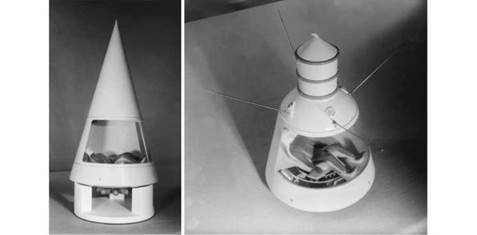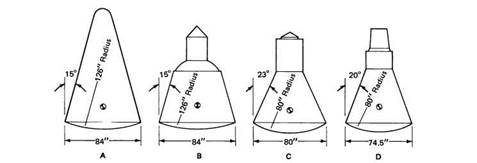A SPACE CAPSULE EVOLVES
Max Faget was one of the original STG formation team. As head of engineering he would personally contribute to the rapid advancement of that program by inventing an emergency escape tower to be used on Mercury and (later) Apollo spacecraft; a ‘survival couch’ which helped astronauts withstand the accelerations of launch and reentry; and by designing the final configuration of the Mercury capsule interior. However he will always be best remembered for designing the Mercury spacecraft with its iconic blunted leading face (the heat shield area), corrugated sides, and a top end that had the appearance of a screw-on bottle cap. Overall, it looked like an old-fashioned television tube.
|
Two early design models for the Mercury capsule. On the left is Shape A and on the right is Shape B, with the position of the astronaut indicated in both cases. Before the configuration was finalized, Shape B depicted a proposal very close to the design selected for the craft. (Photos: NASA) |
In working with that basic shape, and harking back to his earlier conversations with Johnson and Thibodaux, Faget and his team solved one of the trickiest problems involved in the safe recovery of a manned spacecraft – protecting the vessel and its occupant from the ferocious buildup of heat during reentry. Rather than finessing the streamlined, low-drag shapes that earlier missile nosecones had utilized, Faget conceived of a bell-shaped spacecraft that during a reentry of around 17,000 miles an hour would form a supersonic shock wave well ahead of the blunt, curved heat shield in order to cause a great portion of the aerodynamic heating to occur before reaching the spacecraft.
Asked why a space vehicle should not be aerodynamic, Faget once responded, “Why? Because the higher drag vehicles have less heating during entry than the low drag vehicles. When you enter the atmosphere, when something enters the atmosphere, it slows down on account of drag. Now when you have a blunt face like that you create a huge shock wave, and all the drag is related to the shock wave and all the heat goes into the shock wave. If you don’t have that, you’ve got a very streamlined vehicle. Then you end up with what’s normally termed – which is not an accurate term – but it’s called friction drag. This drag is taken by the skin friction of the vehicle and all of the heat goes into the vehicle as opposed to it going into the shock wave.”5
Robert Gilruth stated that the major consideration had always been the shape of the spacecraft and Max Faget was undoubtedly the major contributor, although he recognized that Harvey Allen of the Ames Aeronautical Laboratory was the first, to his recollection, to propose a blunt body for flying a man into space. In Gilruth’s words, “In March 1958 Max Faget presented a paper that was to be a milestone in spacecraft design. His paper proposed a simple blunt body design that would reenter the atmosphere
|
A 1958 sketch of four shapes tested in the evolution of the Mercury capsule. (Illustration: NASA) |
without reaching heating rates or accelerations that would be dangerous to man. He showed that small retro-rockets were adequate to initiate reentry from orbit. He suggested the use of parachutes for final descent, and small attitude jets for controlling the capsule in orbit during retro-fire and reentry."6
As Faget recalled, the other problem concerning him and his fellow designers was the impact high gravitational forces (g-forces) might have on an astronaut within the space capsule.
“It’s quite obvious now that when you launched a man, you put him in a couch so that the Gs come from his back, and then when he reenters, you turn the vehicle around so that the Gs come still from his back. But this was something no one had thought about: how to handle the Gs both during launch and entry. At least they hadn’t thought about it very well. I know one of these things, I think it was the Air Force configuration, had studied it enough to decide that, ‘Yes, we’d better do something about it,’ so they put the man in a sphere and gimbaled the sphere [inside a bluntnosed capsule similar to one of their missile warheads] so that the vehicle would always be going in the same direction, and they’d turn the man 180 degrees within the sphere so that he could withstand the Gs during entry. [However,] it was ever so much simpler, and the configuration became so much better, if you let the blunt end be the rear during the launch, which would decrease the drag on the launch vehicle, and have the blunt end be forward during entry, where you wanted the drag."7
In his role as Chief of the Flight Systems Division at NASA, Faget contributed many of the original design concepts embodied in the Project Mercury spacecraft, and was responsible for numerous innovative spacecraft systems and the task of systems integration.












